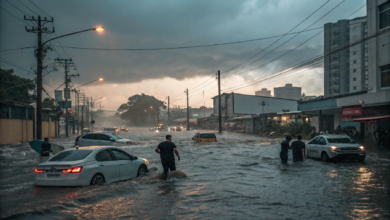Gran Canaria Underwater! Shocking Floods Leave Tourists Stranded and Streets Washed Away!
Gran Canaria Devastated by Flash Floods: Emergency Response Underway

Gran Canaria, Spain – March 4, 2025 – The island of Gran Canaria has been severely impacted by extreme flash flooding following torrential rainfall, prompting authorities to issue urgent warnings for residents and tourists to remain indoors. The Spanish Meteorological Agency (AEMET) has placed the island under a red alert, the highest level of weather warning, due to the potential for life-threatening conditions.
Extent of the Flooding
The heavy rainfall began over the weekend and intensified on Monday, leading to widespread inundation across Gran Canaria. In the town of Telde, one of the worst-hit areas, streets turned into raging rivers, carrying away vehicles and leaving residents stranded. One dramatic incident captured on video showed a car being swept into the sea at Playa Salinetas Beach, underscoring the sheer force of the floodwaters.
The flooding has also affected Las Bachilleras Ravine, where multiple vehicles were submerged or dragged away by the powerful currents. Roads, pavements, and public squares have been left buried under thick layers of mud and debris, significantly disrupting daily life.
Eyewitness Accounts
Local residents and tourists caught in the chaos have shared harrowing accounts of the disaster. María Rodríguez, a shop owner in Telde, described the devastation: “I’ve lived here for 30 years, and I’ve never seen anything like this. The water rose so fast, we barely had time to secure our storefront before it came rushing in. Everything is covered in mud now.”
Another resident, Carlos Jiménez, recounted his terrifying escape: “I was driving home when suddenly, the water started rising. My car stalled, and within minutes, it was floating. I had to climb out through the window and wade to safety. It was like something out of a nightmare.”
Tourists visiting the island were also caught off guard. Emily Carter, a traveler from the UK, shared her experience: “We were in a café near the beach when we saw cars being dragged into the sea. It was surreal. The streets turned into rivers, and people were running for cover.”
Emergency Response and Rescue Operations
Local emergency services have been deployed across the island to assist those trapped by rising waters. Firefighters and Civil Protection units have carried out multiple rescue operations, including the dramatic retrieval of a woman from a partially submerged vehicle.
In Tenerife, the flooding has also led to significant disruptions. At least 80 people became stranded inside a supermarket after floodwaters rendered the parking lot impassable. Emergency teams worked to pump water out of the area to allow safe evacuation.
Despite the ongoing rescue efforts, authorities have stressed the importance of precautionary measures, urging residents and visitors to avoid unnecessary travel and to remain in secure locations. The Canary Islands government has mobilized additional emergency personnel to provide assistance in heavily affected areas.
Impact on Infrastructure and Public Safety
The severe flooding has caused significant damage to transportation networks, with road closures and travel disruptions reported across the Canary Islands. Many vehicles remain stranded or damaged, while landslides have been reported in some hilly areas, further complicating rescue efforts.
The Canary Islands Carnival, a major cultural event that attracts thousands of visitors annually, has also been heavily impacted. Many scheduled parades and performances have been postponed or canceled due to unsafe conditions.
Government Response and Safety Recommendations
Spain’s Prime Minister Pedro Sánchez has addressed the crisis, stating, “Our thoughts go out to those whose homes and possessions have been devastated. We stand in solidarity with all affected communities, and the government is fully committed to supporting recovery efforts.”
Authorities continue to monitor the evolving situation, with meteorologists warning that heavy rainfall may persist until midweek, particularly affecting La Palma, Tenerife, and Gran Canaria. Some areas may also experience thunderstorms, increasing the risk of further flooding and landslides.
Residents and tourists are advised to follow these safety guidelines:
- Avoid flood-prone areas and stay indoors unless absolutely necessary.
- Refrain from attempting to drive through flooded roads or underpasses.
- Stay updated through official sources, including AEMET and local emergency services.
- Follow evacuation orders if issued by authorities.
- Seek higher ground if located in a low-lying or flood-risk area.
Looking Ahead
As floodwaters gradually recede, cleanup efforts are beginning, with volunteers and emergency responders working to clear debris and restore basic infrastructure. However, the full extent of the damage remains unclear, and authorities warn that further storms could exacerbate the crisis.
The Canary Islands, a region known for its tourism-driven economy, now faces a critical period of recovery. While the resilience of its communities remains strong, the increasing frequency of extreme weather events has raised concerns about long-term preparedness and climate adaptation strategies in Spain.
Authorities will continue to assess the situation and provide further updates as conditions develop.




